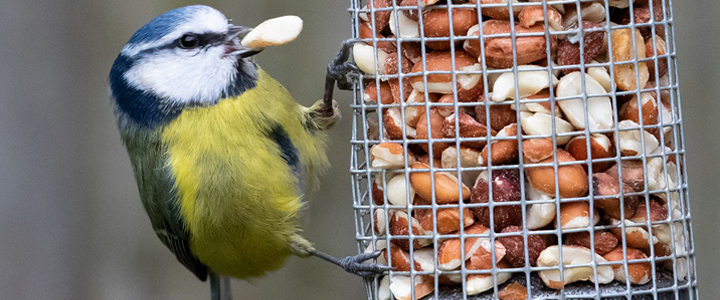
February birds have proved themselves resilient and resourceful during winter, but at this time of year, they face freezing nights, unreliable days and finite food supplies. Providing shelter and food for birds will help them survive at a higher rate and will give you many opportunities for great wildlife pictures.
Top ways to help birds in February:
Provide shelter for birds
A home for birds is just as important as feeding them during February’s cold and unpredictable weather. The first important decision is to determine what species of bird you want to attract as different birdboxes attract different birds.
The popular small hole nest box should be placed around 3m high and have an entrance hole between 25-32mm in diameter. The size of the entrance hole will determine which species of bird is attracted.
- Blue, coal and marsh tits find a 25mm hole suitable.
- The 28mm hole will attract great tits and tree sparrows.
- A large 32mm hole can accommodate woodpeckers, sparrows and nuthatches.
To attract wrens, robins and pied wagtails, an open front birdbox should be used, positioned 1.5m high. The open front birdbox works best when it is surrounded by vegetation such as shrubs and creepers to provide additional cover for the birds.
When it comes to bird boxes, they should be positioned in protected areas away from direct sunlight, wind and rain, out of reach from predators and with a clear route to entry.
As freezing conditions are frequent, going the extra mile and putting a few inches of clean, dry grass or wood shavings at the bottom of the birdbox can help greatly.
Provide food for birds
Bird feeders filled with seeds, fat balls and fat cakes will bring regular visitors to your garden and having a wild bird wildflower meadow will provide birds with natural seeds during winter months. As with the birdboxes, different species prefer different feeds and ways of feeding.
- Sunflower hearts in hanging plastic feeders are used mainly by tits, sparrows and finches.
- Peanuts in hanging mesh feeders are used mainly by tits.
- Fat balls in hanging mesh feeders are used mainly by tits and sparrows.
- Goldfinches use nyjer seed feeders.
- Robins and blackbirds use oat, fruit and fatty mixes on a ground feeder or bird table.
*Bird feeding top tips*
When the ground has frozen a bowl of mealworms will be a welcome sight and a sought after treat.
Hand-feeding garden birds such as robins is quite simple. Some can be tamed and will demand food when they see you creating unique encounters.
Start planning for the warmer months by sowing wild bird wildflower seeds to provide natural seeds for birds to feed on throughout future winter seasons.
Provide water
As vital as food, providing water is equally important, especially when other sources are frozen. Here are some tips to make an attractive water source for birds.
- A simple, sturdy birdbath that is light enough to clean and refill easily is all that is needed to keep your visitors happy.
- Keep the birdbath low to mimic natural water sources that birds use in the wild, ideally below 1m.
- Birdbath location is crucial as the visiting birds will need a safe approach, a little cover and a place to flee to when in danger.
- Clean birdbaths regularly to remove feathers, leaves, insects and algae that gather over time. Birds love a freshly cleaned birdbath.
- During cold weather, consider adding a temperature-controlled water heater to keep the water from freezing over, providing a vital water source when all other sources are frozen.
- As heated water can freeze on birds feathers when they bathe in cold weather, access should be restricted to drink only by using large rocks.
- A shallow water feature is a fantastic birdbath as the moving water sparkles in the sunlight and catches the attention of birds, attracting more birds to the area.



